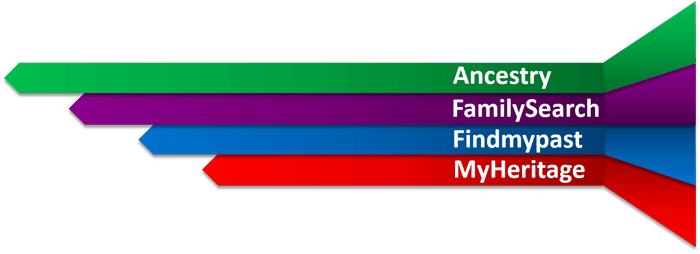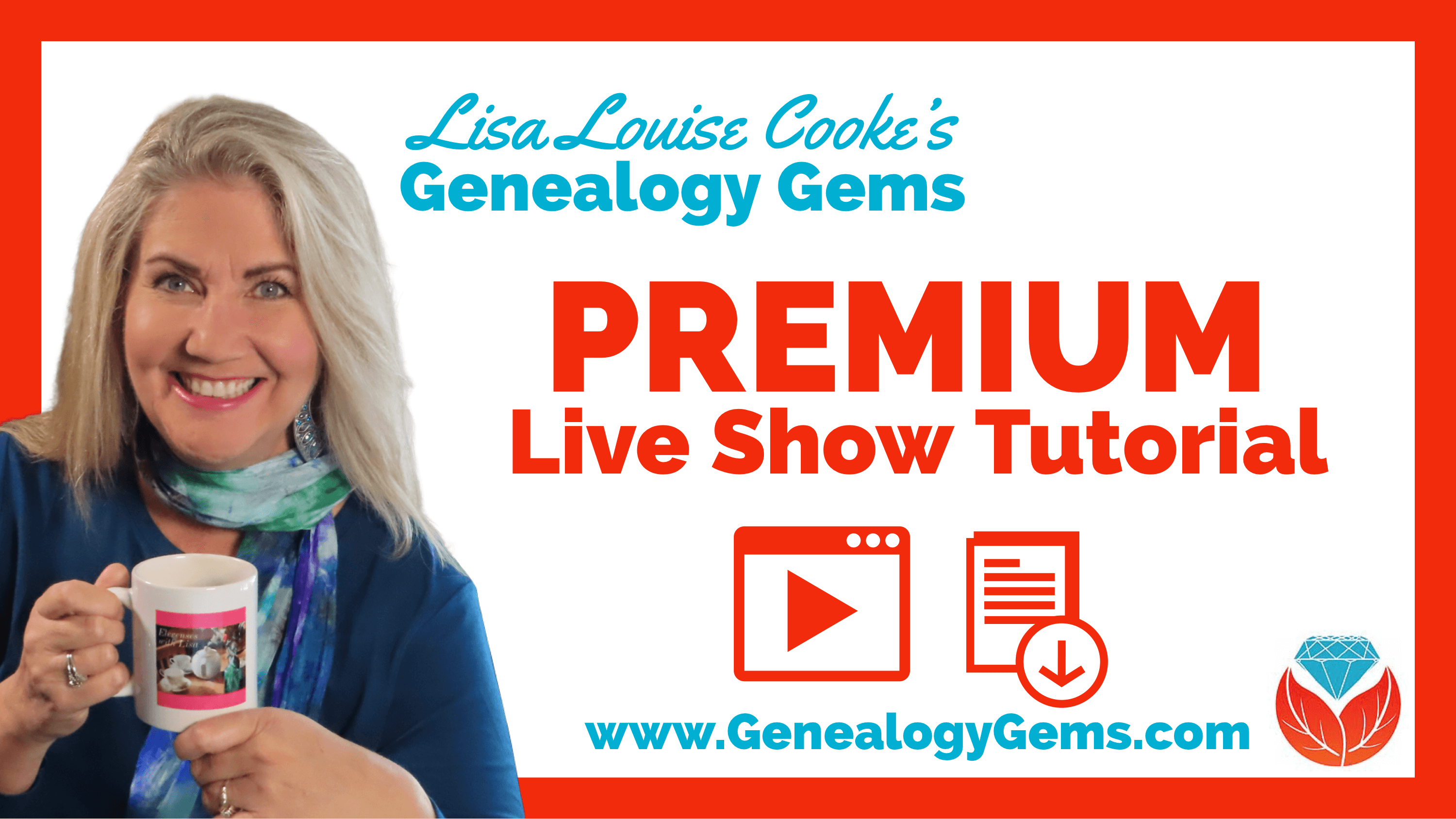Why You Should Have a Free FamilySearch Account–And Use It!
A free FamilySearch account gives you access to more historical records and customized site features than you’ll see if you don’t log in at this free genealogy website. Here’s why you should get a free FamilySearch account and log in EVERY time you visit the site.
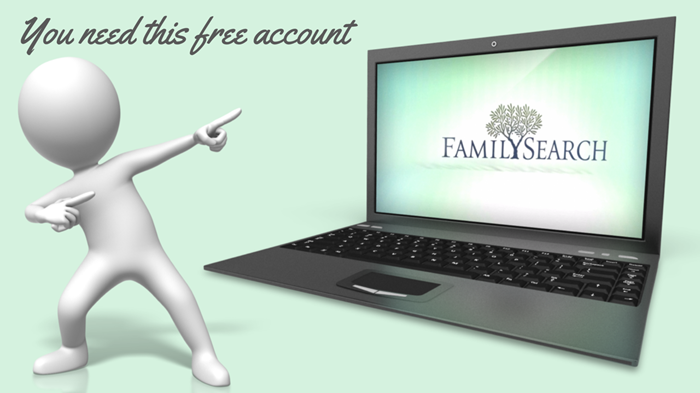
This post is part of our ongoing commitment to help you get the most out of the “Genealogy Giants:”
In this post, I comment on a recent announcement from the free giant everyone should be using: FamilySearch.org.
Why you should have (and use!) a free FamilySearch account
FamilySearch.org has always allowed free public use of its site. But beginning on December 13, 2017, the site will now actively prompt visitors to register for a free FamilySearch account or to log in with their existing accounts. Anyone can continue to search the catalog and user-submitted genealogies, explore over 350,000 digitized books, learn from the Wiki and the learning center, and even view user-contributed photos and stories. But by requesting you to log in, FamilySearch wants to remind you that this is your path to even more free records and services on the site.
Here are my top three reasons to have and use a free FamilySearch account:
1. Access more free historical records on FamilySearch.
We’ve talked a lot in recent months about best strategies for accessing digitized and off-line historical records at FamilySearch. Some of the digitized records on FamilySearch are there courtesy of a partner organization, which may restrict record access to those who log in on the site.
One woman had an “ah-ha” moment of realization after reading FamilySearch’s announcement. She posted in the comments, “Though I have had a free account for some time, I did not realize that FamilySearch was not giving me full access to information in record searches just because I had not logged in. Maybe I need to redo my past searches as a logged-in account holder.”
2. Participate in the global Family Tree.
As I more fully describe in my quick reference guide, Genealogy Giants: Comparing the 4 Major Websites, FamilySearch’s online family tree is different than the tree systems used at the other major family history websites. Instead of creating your own personal tree, you participate in a collaborative, unified family tree of the world. As a logged-in visitor, you can enter your information, then that of your parents and their parents, etc. until you connect to deceased individuals who are already on the tree. (Information about living individuals is always privacy-protected.) Then you may, with other descendants, contribute what you to know to an ancestor’s profile.
Anyone may make changes to these public profiles, which may at times be frustrating. But it also allows for more focused collaboration. This is a great place to see a virtual compilation of others’ research on particular ancestors without having to search others’ personal trees individually, as you do on other sites (remember to look for their source citations and verify what others say). The Family Tree on FamilySearch is also a great place to digitally archive family documents and photos where other researchers may see and appreciate them for free. As you can see in the screenshot below, logging in also helps you see how others have identified the folks you see in your search results:
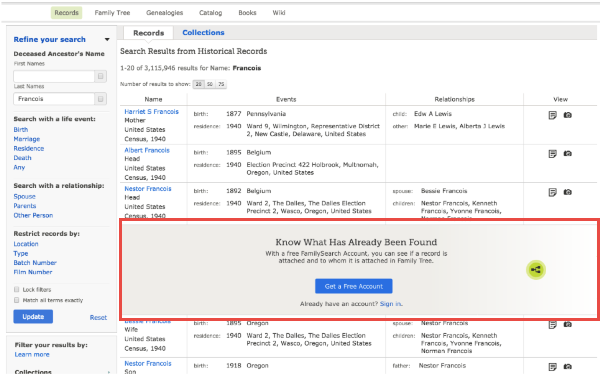
3. Get customized help.
Those who log in with a free FamilySearch account have access to one-on-one assistance through the website. If you have a question about using the site, accessing records, finding additional records about your ancestors, or even how to understand the records you’re looking at, you can email or call a live support person for help. Your login also sets you up to receive customized alerts and seasonal messages (like “Did you know your ancestor fought in the War of 1812?”) and a dashboard experience with at-a-glance reminders of record hints awaiting your review, where you left off in your last online session, tips about what to do next, and more. Here’s what the dashboard looks like:

How to get (or recover) a free FamilySearch account
See Registering to use FamilySearch.org for information about creating a free account. FamilySearch accounts have always been free and, the site assures us, will continue to be free. You will need to provide your first and last name, a username, a password, and an email or mobile phone number.
According to FamilySearch, your login and other personal information:
- enables collaboration in the Family Tree and Memories areas of the site (you control how much information is shared)
- “allows you to send in-system messages to other users without revealing your personal identity or email address”
- “allows FamilySearch to send you emails and newsletters (you can specify how many emails, if any, you receive)”
- enables communication when you contact their online support team for help
- will not be shared “with any third party without your consent”
If you’ve already got a FamilySearch account but have forgotten your username, click here. If you’ve forgotten your password, click here.
Genealogy Gems Brings You Genealogy Giants
 Each of the “Genealogy Giants” has so much to offer family historians around the world! But it’s hard to keep them straight, compare their top features, and get the most out of them without some inside help. That’s why we published the must-have quick reference guide, Genealogy Giants: Comparing the 4 Major Websites, your personal comparative tour of Ancestry.com, FamilySearch, Findmypast, and MyHeritage.
Each of the “Genealogy Giants” has so much to offer family historians around the world! But it’s hard to keep them straight, compare their top features, and get the most out of them without some inside help. That’s why we published the must-have quick reference guide, Genealogy Giants: Comparing the 4 Major Websites, your personal comparative tour of Ancestry.com, FamilySearch, Findmypast, and MyHeritage.
This inexpensive guide can save you hours of wasted time hunting down the records you need. It can save you hundreds of dollars by helping you invest in the genealogy websites you most need to use right now–because your research needs change right along with your growing family tree! The guide is available for your immediate reference as a digital download or get a handy, high-quality printed copy you can keep with your genealogy research files.
How to Upload Your E-books to Your Own Google Play Books Library
These days we are all collecting more ebooks than ever before. We also have more devices than we’ve ever had before. Here’s a solution that gives you access to your ebooks from one convenient location no matter which device you are using.

The Advantage of eBooks
While you may love the feel of the pages of a book rifling through your fingers, there is a distinct advantage to collecting many of your genealogical reference materials and books ebooks. They don’t take up precious shelf space in your house!
However, I don’t live in a digital fantasy-land. I’m keenly aware that there are some challenges you may want to avoid:
- purchasing an ebook and downloading it to one device, and then trying to figure out how to access it on your other devices
- corralling your ebooks from different sources all together
- having to pay for an app or web service to manage them
Don’t Reinvent the Wheel
If you’ve ever attended one of my genealogy classes, or watched one of my videos, at some point you’ve probably heard me say that I use Google Books on a daily basis for genealogy. I don’t say that just because the service provides access to over 25 million books, many of them fully digitized and searchable, and downloadable. It also provides you with your own personal library. Let’s take a look at how Google Books and Google Play Books work together to make that possible:
Google Books is a free and powerful service that also allows you to have your own library within it called My Library. As you search for and find ebooks to aid you in your genealogical research, you can save them to your library.
Google Play Books, is sort of the other side of Google Books. It is a vast ebook store that includes a feature called My Books. When you purchase an ebook, it is saved to your My Books. However, it also includes all ebooks that you have saved to your Google Books My Library. Even better, it allows you to upload your own ebooks! This makes it a central clearinghouse for all of your ebooks.
Here’s the bottom line. Think of My Books and My Library as the same thing in two different places: a personal library for your free, purchased and uploaded ebooks. The only reason they have different names is because Google Books has evolved over time into a book store as well. Don’t worry about that. Just know that whether you are searching through Google Books, or shopping in the Play book store, your library is right there with you, no matter what device you are using.
How to Start Using your Google Play Books Library
To get started, all you need is a free Google account, which you very likely already have. Go to https://play.google.com/books and sign in. In the menu on the left, click My Books. If you have ever saved a free ebook to your My Library in Google Books you should now see it on your screen.
This library is a place where you can save, upload, and access your digital books from any mobile device. This means everything is conveniently in one place, and accessible from all of your computing devices, both Apple and Android. You’ll have the freedom to read your favorite books on the go, and to access your digital genealogy research library at the drop of a hat.
Yes, there are some other services out there that could also do the job. But if you’re like me and don’t want to invest the time to learn and pay for yet another tech tool, Google Play Books is a great solution, because we are already using Google Books for our genealogy research.
How to Upload Your Own eBooks to Your Google Play Books Library
Let me walk you through the simple steps to putting this free tool to work for you:
1. First, open your web browser and log in to your Google account.
2. Go to play.google.com/books.
3. Click Upload files.
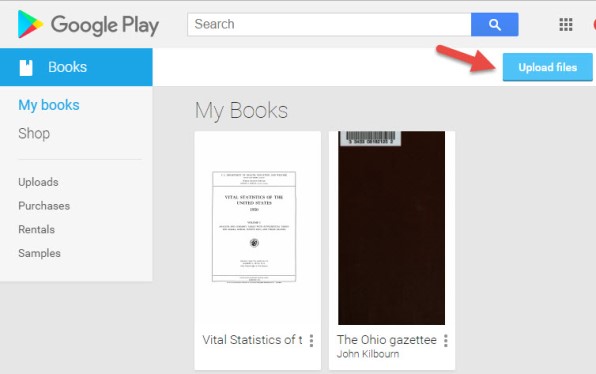
4. Select your ebook files from your computer folders, or drag them into the box shown. You can also click on My Drive to select files from Google Drive. You can choose epub documents or PDFs.
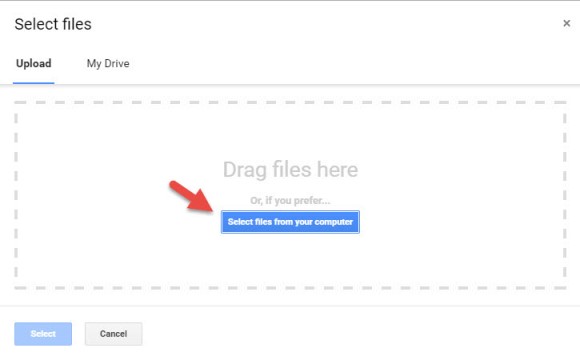
Now, let me stop right here for a second and distinguish between doing this on a computer, and doing it on a tablet or smartphone. What I’m illustrating here is on a computer. I always recommend when you purchase ebooks to download them first to your computer, regardless of whether you plan on uploading them to Google Play Books. However, if you do want to do this on a tablet, for example, there are currently two options from which to pull your ebooks:
- “My Drive” which is Google Drive, or
- click “Select files from your computer” then tap “More” and select Dropbox.
Trust me, things will work more smoothly if you use your main computer as your hub for downloading, and then upload directly to your Google Books library.
Other things that are good to know:
- It may take a minute or two to upload an entire book.
- The cover will be the title page, not the actual dust-jacket cover you might be used to.
- Currently, you can only search within books you obtain from Google (both free and paid), not the ones you upload.
- You can upload 1,000 books into your Google Play Books library.
- It’s private. Your books are only visible to you when you login to your Google account; you’re not sharing them with the world.
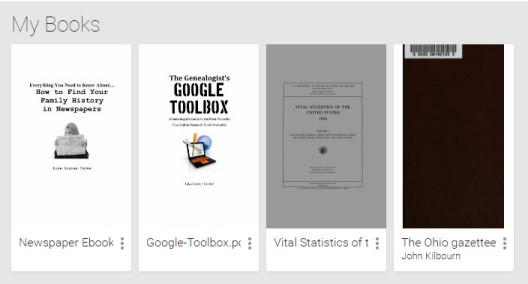
Your Google Books Library on Your Mobile Device
So now you have found free historical ebooks on Google Books (if you haven’t, take a moment and click here to read my article about using Google Books) and saved them to your Google Books My Library. Then, you uploaded your own ebooks and PDFs to Google Play Books. The final step is to jump on all of your smartphones and tablets and head to the app store. Search for Google Play Books and download the free Google Play Books app to each device. Sign in to the app with your same free Google account, and you’ll have access to all of your ebooks. Your library can now travel with you in your purse or tucked into your pocket.
In the app, tap the three horizontal lines icon in the upper left corner, and then tap My Library. You’ll find your ebooks sorted under the following tabs:
- All Books
- Purchases
- Uploads
- Samples
By tapping the three uneven horizontal lines icon in the upper right corner, in each category you can sort your books by:
- Recent
- Title
- Author
Those Pesky Variable Formats
 eBooks come in several different formats. While I’m not covering in this article how to convert file types or deal with DRM protected books, there are resources available to help you do so.
eBooks come in several different formats. While I’m not covering in this article how to convert file types or deal with DRM protected books, there are resources available to help you do so.
The answer? Just Google It!
And if you need help figuring out how to effectively Google search, I have a book for that! The Genealogist’s Google Toolbox–the ultimate guide to using all of Google, including a full chapter on Google Books.
PDF – I Love You!
Many white-papers, scholarly works, and quick reference guides come in PDF format, and they upload like a breeze.
PDFs are so versatile, and they play ever-so-nicely with Google Play Books. It’s just another reason to love your Google Books library.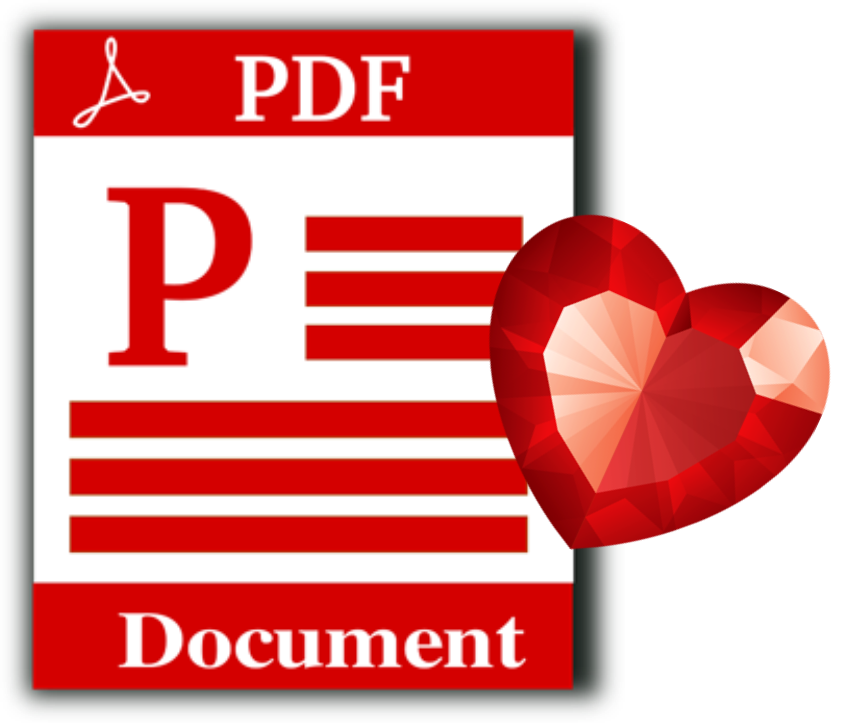
Stock Your Google Books Library
Are you feeling like your Google Books Library has room to fill? All of our quick reference guides are easy-to-upload PDFs, and all of the following genealogy resources are available as digital downloads in the Genealogy Gems store:
- NEW: Genealogy Giants: Comparing the 4 Major Websites Quick Guide
- Mobile Genealogy: How to Use Your Tablet and Smartphone for Family History Research
- How to Find Your Family History in Newspapers
- Genealogy Gems Ultimate Research Strategies
- Evernote for Windows for Genealogists Quick Guide
- Evernote for Mac for Genealogists Quick Guide
- MyHeritage.com Cheat Sheet
- NEW Irish Guides (get BOTH and SAVE):
- 10 DNA Guides by Diahan Southard, available individually or in bundles.

For a hand-picked list of novels and other great leisure reading for genealogy lovers, visit the Genealogy Gems Book Club page. I know you’re going to love our suggested best-sellers and best-kept-secrets about family, the search for identity, and fascinating stories in history.
1950 US Census Indexing with FamilySearch
The 1950 census must be indexed so that we can search for relatives by name, location and much, much more. You can help with this exciting project, and no special skills or background are required. Jim Ericson of FamilySearch 1950 Census Community Project explains what’s happening and how you can get involved.
Lisa: The 1950 US federal census was released by the National Archives just a short time ago on April 1 2022. But it was just a release of the digitized images of the census pages. The indexing of those records happens afterwards. It’s really the indexing that makes it possible for all of us to be able to search the records and find our families. Here to tell us about that really important indexing project. To get all this done is Jim Ericson from FamilySearch. They are heading up this project. Welcome, Jim.
Jim: Thank you, Lisa. It’s wonderful to be here with you today.
Lisa: I know you guys are so busy. You’re right on the heels of Rootstech which just wrapped up. And now we’re here with the release of the US Federal Census for 1950! Do you have somebody you’re looking forward to seeing in that census record?
Jim: Yeah, both of my parents will be there. My dad will be 20 years old. He turned 21 that year after the census. And my mom is 15, she will just have had her 15th birthday.
I know where my mom was. She was in Salt Lake City. But I have no idea where my dad was in 1950 as a 20 year old. He’d left college and I know that he had enlisted in the in the army. But I don’t know. He also worked in San Francisco for a couple of years. I don’t know if he’ll be in San Francisco, or where exactly where he would have been in 1950 when the census was taken so there’s a little mystery right there.
Lisa: Absolutely, and that’s a perfect example of why the indexing is so important, because you’ll be able to name search for him when this is done.
The History of FamilySearch
(2:07)
Before we jump into that indexing project, for those who maybe aren’t familiar or haven’t used FamilySearch, tell us what familysearch.org does and what it offers the genealogist.
Jim: FamilySearch is a nonprofit organization. We were founded in 1894 as the Genealogical Society of Utah.
FamilySearch is more of a recent incarnation of the organization that kind of reflects when we went online, and when we started publishing CD ROMs in the 1990s.
We’ve been microfilming and digitizing records since 1938. We started a worldwide project to go and collect records from around the world. Microfilm was really the innovation that allowed us to store all those records in a library. Getting a whole bunch of books or physical records in one location was difficult.
Since then, all of our record operations are now digital. All of our records are captured digitally now. We have worldwide operations in hundreds of countries. We publish over about a billion records a year.
As a nonprofit, we partner with commercial entities who have an interest in profit, because we know that they know how to innovate. And that also helps our resources go further through partnerships with these commercial entities. The 1950 census is actually an example of that sort of a partnership. We’re working on this with Ancestry and using the resources that they have.
FamilySearch has a collaborative family tree where you can see what others know about your family. We have, like I mentioned, 10 billion records that are online. We have free resources to learn how to do family history. And we really try to just bring people wherever they are, to the experiences that can help them learn about their family.
(04:32)
Lisa: It’s amazing how much it’s grown! I remember the days of the CD ROMs with the record sets that we used to order. And now so much is available for free from home. Users just need to sign up for a free account to use the website and take advantage of the records. And I love the Wiki. It’s such a wonderful treasure trove of knowledge when it comes to genealogy research
Let’s talk about the most exciting and the newest record collection, which is the 1950 census. When it was released by the National Archives did you get all the images? Does that mean instantaneous publication on familysearch.org? How did that work initially?
Jim: Well, 10 years ago, in 2012, when they released the 1940 census, we were actually waiting at the National Archives with a van and hard drives. We had to transfer all the data onto hard drives and take them to our data facility in Virginia.
This time, everything was available online. Everything was downloaded and uploaded to our servers immediately. There was high demand. So that was one of the challenges that we faced was making sure that we’re going to be able to download those images, over 6 million images is a lot of images to be able to download. And those images include records for 151 million people. So that’s a lot of information at high quality, resolution. So that was actually the first hurdle.
And since we are doing this project with Ancestry, we also have to wait for Ancestry to do the same thing and download the images, to be able to process them to create their computerized index with their own handwriting recognition technology that then comes to us. It makes it so much easier to review an index as opposed to starting with transcription from scratch. So, there are so many innovations that have taken place. But from the National Archives, the online delivery of images was one of those innovations.
Lisa: How fantastic to be able to do that online. I can imagine that speeding it up. And then you’ve got artificial intelligence, which is already impacting how we use genealogy websites, how we access digitized books, and here you are using it to help index the records.
(7:28)
I’d love to know kind of a comparison between the speed at which you indexed the 1940 census which I thought was pretty darn quick to how that looks for 1950.
Jim: There is a great question, and we’re still learning how this is going to play out with the 1950 census.
The history of census indexing by FamilySearch
(7:54)
One of the first projects that we did as FamilySearch when we were publishing, CD ROMs was the 1880 census. The 1880 census took us more than a decade to press on to CD ROM. It was a huge project! It was crowd sourced, but before the advent of the internet. It was sending packets and physical papers around and then gathering them and then creating a CD ROM.
We went from a project like that, to doing the 1940 census just over a decade later in a matter of about six months. So already the technology was just astounding because of what you’re able to do because of the internet. Now you have the artificial intelligence, the handwriting, character recognition, and then you have innovations that we’re doing with the crowdsourcing. And all of a sudden, you’re able to take those tasks that we’re all human, I guess bounded by human capabilities, and you’re now allowing the computer to do what the computer can do.
With the 1950 census, we are actually indexing or reviewing this automated index for every single field that was captured in the 1950 census. It’s way more data than we were dealing with for the 1940 census. Because of the cost and the time, we just wanted to make sure that we just had the most logically relevant fields captured, so occupation, and some of those fields were seen as extra fields. But for 1950, we recognize that we can do a lot more in terms of the experiences that we can provide and that these other entities can provide if we have a full index, so that’s one of the big innovations. It’s going really well.
When will the 1950 census index be complete?
(10:08)
We have a goal to get it all done by Flag Day, so that’s June 14. That will be about two months from when we really got the project going and up to speed. That just depends on how many people come and participate.
There’s more than one way to participate. We feel like we have a lot of options, and it’s more accessible than it’s ever been because of how recent (the 1950 census) is. Recognizing handwriting from 1950s is not that different from recognizing handwriting from a week ago. Things haven’t changed that dramatically. And so, it’s a really accessible experience. And these are people that everybody knows. It’s kind of fun to come in and see what you can find in those areas where your family is from.
Innovations in the 1950 Census Index
(11:07)
Lisa: Exactly. You said something which I hope everybody really appreciates, which is that you indexing every field. I mean, you must have gotten excited when you heard that was really going to be possible. It’s a game changer because now you can slice and dice data in so many ways. You can look up everybody who worked on the railroad or whatever the fields are that were filled out. What do you think the impact will be of that? Will that change anything about genealogy research?
Jim: Yes, it will. And not just genealogical research but also understanding the makeup of our country in 1950. And really understanding the history of our nation because that is part of your family history is enabled by capturing those additional fields. Being able to see differences in income, differences in occupation from region to region, being able to easily see, neighborhoods.
The address for the 1950 census is similar to the 1940 census in that it’s a vertical capture down the side of the forms. So that is something that just allows people to see what’s there today, if their house is still there. These are experiences that that we’ve dreamed of but without the index it is impossible to provide that sort of an experience. And so now with the commercial entities and what we’re trying to do, you’re going to have a lot of different experiences now that are unlocked and available because of these innovations. And especially with Ancestry’s (technology) it has enabled us to do this.
Is the 1950 census available for free?
(13:06)
Lisa: Since you’re partnering together, is it available at Ancestry for free as well as for FamilySearch?
Jim: Ancestry will make their own businesses decisions. But yes, initially, it’ll be available for free. They’ve opened up the 1940 census recently, and that’s been available for free. I don’t know what all their future plans are. It allows them a lot of flexibility on how to do that. Of course, we make everything we can available for free at FamilySearch.
Again, there’s going to be a lot of different experiences that are available around this record set. So, it’s exciting going all the way back to how the National Archives made it available. It’s really democratizing the records. I think their goal is to just make it accessible to as many people as possible. And then it’s these other organizations that have a vision for what they can do with those records.
Lisa: Yes, and you guys certainly had the vision around the indexing project. That’s something that is such a skill that you’ve all developed and really fine-tuned. You’ve been able to crowdsource so much of what then becomes available to everybody.
Tell folks how they can get involved in it. And I’m really interested in some of the changes. I was very excited to hear that people will be able to have, in a way a more personal indexing experience. Tell folks about that.
Jim: Something that everybody wants to do when they come in and volunteer and get involved in a project is to find their own family. That will be expedited. When the index is published and available, after it’s been reviewed, everybody’s going to have that wonderful experience. But even on the review side, we’ve made it so people can search for a specific location down to the county level, or, in some cases down to the city level. Then you can actually search for a surname, or last name within that location. Now, if your family hasn’t already been reviewed, you’ll be able to review it if it hasn’t been reviewed. That just means that it’s going to be published sooner, because progress has already been made. And then you can come back and review it.
How to make corrections to the 1950 census index
(15:42) If for some reason, the person who reviewed it did it wrong, you can still make corrections. We do corrections on FamilySearch. Ancestry does corrections on Ancestry. And we are sharing whatever corrections are made on FamilySearch with Ancestry so they can get the benefit of any corrections that are made on our website as well. So that’s terrific.
For the 1940 census we had 163,000 people come and help and get involved. And with how easy it is for 1950, we think that we’ll have well over 200,000 people who will come and want to review these names.
How to volunteer to index the 1950 census
(16:30) If you want to get involved, there are a couple different places you can go. But the easiest place to remember is familysearch.org/1950census. And on that page, there’s a lot of information. Near the top of the page there’s a big link to join the project and to come over and participate.
The project is ongoing. All the states are there, some have already been published. Come and get involved and see what you can do. It’s going very quickly, and people are really enjoying it. We’re glad that it’s along as quickly as it is.
Lisa: Volunteers can do this from home from their computer. Is there a certain minimum commitment that they have to make or a certain minimum amount of technological ability?
Jim: No. This is again one of the things that’s kind of fun. I mentioned that briefly before there’s actually more than one experience or a way to participate.
Household Review
(17:42) The standard way that most people who’ve done it before want to participate is what we call the Household Review. With the household review we try to identify from the head of the house, all the members of the household or the family to the next head of the house. That can sometimes cross pages on the census forms. That is an every field review. You can review as many of those fields as you want. And then the next person can come and pick up where you left off. So that’s really fun. It does require you to be on a computer.
Name Review
(18:27) There are two other types of tasks. One doesn’t require you to be on a computer. You can be on your handheld device, your smartphone. It is what we call Name Review. So, instead of reviewing all of the fields, you can download our app called Get involved. FamilySearch Get Involved is available on the iTunes Store or the Apple Store, as well as from Google, the Android store. You can download the app and you can just start looking at the images where we have the names of the people in the census. Then you can compare that with what the computer thinks it is. You can either say yes, that’s right or no, and you can actually enhance or fix what the name is. You can do hundreds of these in an hour. I’ve done it, and it’s a fun activity. It’s really engaging if you like seeing that you’re making a difference in terms of volume. It’s a really fun way to participate.
Again, the computer doesn’t always get it right. So, you have to be really careful in the review process. But it’s super easy to just look at the image and look at the index value for the name and just make sure it’s right. You don’t have to have the app though.
Header Review
(20:00) So, there’s the Household Review or the Name Review. And then the other task is the Header Review.
every census image, every census ledger, has a header that includes all of the location information and the information about the enumeration itself. And reviewing that is a separate task. We broke that one out because again, the data is formatted differently. If you want to go in and help us, those have to be done as well to be able to publish the dataset. We invite you to come in and see what states still have the header review available, and you can help us finish out that as well. It’s not as exciting because it doesn’t include the names of the people. But it still has to be done to be able to publish the reviewed index.
Lisa: I hadn’t thought about the header, but that’s pretty important. If that’s not right, then we get way off track pretty quickly. It includes our enumeration district number, the county, etc. That makes a lot of sense.
Well, Jim, it sounds like you guys have really been innovating over at FamilySearch. We’re grateful. We’re grateful that you’re giving everybody watching an opportunity to also give back a little bit and we can all pull together and get this done by Flag Day.
Volunteer to help index the 1950 US census at familysearch.org/ 1950 census.
Thank you so much. And I sure hope we’ll talk again even before the 1960 census!
Jim: I hope so! Thank you, Lisa. It’s been a pleasure to be with you today.
Resources
Downloadable ad-free Show Notes handout for Premium Members.
Learn more about becoming a Genealogy Gems Premium Member.
Free Genealogy – How to Find Free Genealogy Records
Elevenses with Lisa Episode 21 Video and Show Notes
Live show air date: August 20, 2020
Join me for Elevenses with Lisa, the online video series where we take a break, visit and learn about genealogy and family history.
How to Find Free Genealogy Resources
In the genealogy community it’s often said, “Only a fraction of genealogical records are online.” That’s true indeed, but it’s not a reason not to start your search online. A more helpful and accurate piece of advice would be “while not everything is online, all search for genealogical information starts online.”
The reason for this is simple. Online research before you go will reveal:
- If the materials are available at a more convenient location
- If the materials are available somewhere online for free
- The call number, location, and other specific information you need to quickly access the materials once you arrive.
- Details about gaining access to the facility and materials.
The last bullet point above will help you avoid the disappointment of discovering an unforeseen closure, or that the specific records you need are actually help at a satellite location.
New genealogical information and records are uploaded daily to the internet. Some of this information is available for free. In this article and episode we will cover strategic ways to locate and access free genealogy online.
The Amount of Data Continues to Increase – Read more about the growth of online information here.
The Path of Least Resistance to Free Genealogy
Most genealogists want to obtain records at the lowest available cost with the least amount of travel. Therefore, always starting your search online just makes good sense.
Here’s our path of least resistance:
- Free and Online: FamilySearch, Google, WorldCat
- Online and Subscription: Ancestry, MyHeritage, Findmypast, niche sites
- Free and Locally Offline: Libraries, Archives, Universities
- Offline and Distant: Examples include the National Archives, Allen County Library, Family History Library, NEHGS
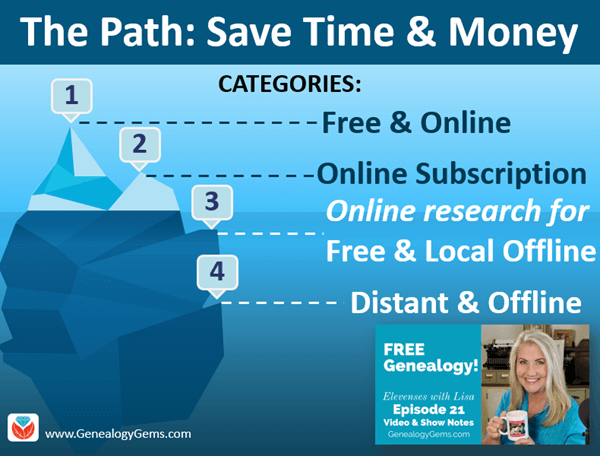
www.GenealogyGems.com
Free Genealogy Records Online
FamilySearch
FamilySearch is a free genealogy website.
The FamilySearch Catalog: New digitized images are added daily from microfilms & digital camera operators. These include books, maps, compiled family histories, and more. The catalog also includes materials that are not online but are available at the Family History Library in Salt Lake City or through Inter-library loan.
The FamilySearch Wiki is a free online genealogical guide comprised of more than 93,000 articles. It covers 244 countries, territories, and islands. It includes links to genealogy databases and online resources as well as how-to information.
Use the FamilySearch Wiki Watchlist to follow pages of research interest. Here’s how to watch Wiki pages for new and free genealogy content:
- Log in with your free FamilySearch account
- navigate to the desired page
- click the Watchlist link in the upper right corner of the page.
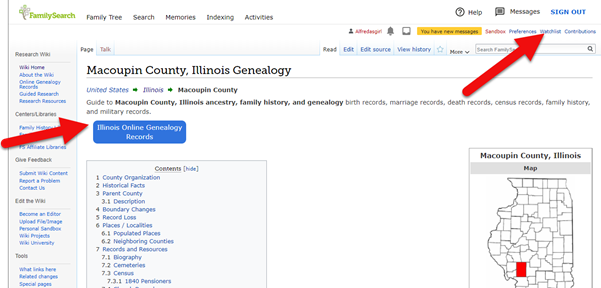
Look for the Watchlist link, and the blue buttons that lead to free online genealogy records for that location.
Google.com
Google is still your best bet for finding sources both online and offline.
You can dramatically improve your search results by incorporating search operators into your search. Watch episode 13 of Elevenses with Lisa to learn about how to use search operators when googling for genealogy.
Get all of the Elevenses with Lisa episodes here.

Learn how to google for free genealogy in episode 13.
Find More Free Genealogy with these Google Search Strategies
The most comprehensive and best-selling book on the topic of using Google for genealogy:
The Genealogist’s Google Toolbox, by Lisa Louise Cooke.
Google Alerts Finds Free Genealogy for You
Set up free Google Alerts to be on the lookout for new and updated search results. You’ll receive them by email, and you can control the frequency.

Google Alerts do the work of searching for free genealogy for you.
How to Create a Google Alert:
- Highlight and copy (Control C on Windows or Command C on Mac) the search query that you typed into the Google search box
- Go to www.google.com/alerts
- Sign into your free Google account
- Paste (Control V or Command V) your search query into the Search Query box on the Google Alerts page
- Select the Result Type you desire (ex. Everything, News, etc.)
- Select how often you wish to receive alerts
- Select How Many results you want to receive (I recommend Only the Best Results)
- Enter / Select the email address you want your alerts to be sent to
- Click the Create Alert button
Partnerships Make Free Genealogy Available
Many of the genealogy giants enter partnerships with each other in order to facilitate digitization and indexing of genealogical records. This means that the same materials may be found in different locations on the web, and sometimes for free.
WorldCat.org
17,900 subscribing member libraries in 123 countries collectively maintain WorldCat’s database which is the world’s largest bibliographic database.
Use WorldCat to check that you are indeed accessing the resource from the most convenient repository and if it’s available for free. Here’s how:
- Run your search
- Click an item
- Under Find a Copy in the Library enter your zip code
- The library closest to you will be listed at the top
Once you get your search results, look to the left in the Formats box. There you can quickly narrow down to only items that are online by clicking boxes like Downloadable Article. Some of these may require a log in on the website you are referred to.
How to Find Free Records at Genealogy Websites
Ancestry.com
If you don’t have a paid subscription to Ancestry.com you can still take advantage of their many free collections available here. Then read my article Why Use Ancestry for FREE if You’re NOT a Subscriber for more tips of free stuff at Ancestry.
MyHeritage.com
To find free records at MyHeritage.com, go to https://tinyurl.com/LisaMyHeritage. In the footer menu of the website, click on Historical Records. Then fill in your search criteria. (Update: If you don’t see Historical Records in the footer, go to Research > Collection Catalog and search on the keyword “free.”) Scroll down the search results and look for the green free tags.
Findmypast.com
To find free records at Findmypast which specialized in British genealogy but also includes records from around the world, go to https://tinyurl.com/FMPLisa.
(Some links in our articles are affiliate links. We will be compensated at no additional cost to use when you use them. This makes it possible for us to bring this free show to you. Thank you!)
Google Site Search Can Help Locate Free Genealogy
A site search works like many search operators as previously discussed in Elevenses with Lisa episode 13 (watch and read here.) It provides Google with specific instructions about the type of search you want to conduct with your search terms and keywords.
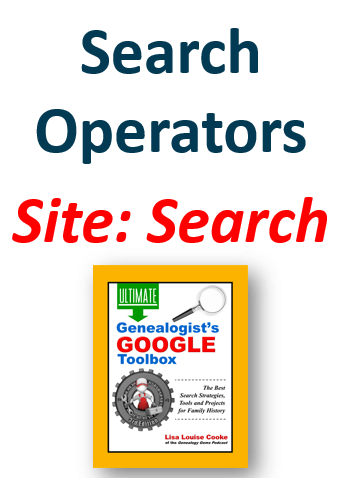
This Site search tip comes from Lisa Louise Cooke’s book The Genealogists’s Google Toolbox.
Site search runs your query only on the specified website. This is extremely helpful and efficient if:
- you have a particular website in mind that you want to search,
- you aren’t having success using the search field provided by the website,
- the website you want to search doesn’t have a search field.
Here’s an example of a Site search:
Free Pennsylvania site:ancestry.com
Try running the search above for yourself. You’ll find results that include many free genealogy records pertaining to Pennsylvania. Substitute the words to meet your search needs.
Construct a Site search for Free Genealogy by first typing in the words and phrases you wish to search for. Include the word free. Leave the appropriate spacing between them and follow the last item with a space. Then type site: and add the website home page address (URL). You can copy the URL and simply paste it in place. There is no space between the colon and the URL. And note that www is not required.
Searching for Offline Local Sources with Free Genealogy Information
To find what’s local and free:
- Search WorldCat.org (be sure to use the Zip Code filtering to find the genealogy materials at the location closest to you.)
- Use Google to search.
- Find your local Family History Center here. These centers have unique free resources as well as free access to some subscription genealogy websites.
When you find a library, archive or other repository, visit their website and look for:
- Databases they offer
- Their online catalog to plan your research
- Other associated libraries
- Details on planning a visit
Get Free Genealogy Help on Facebook
Search for Random Acts of Genealogical Kindness (RAOGK) on Facebook.
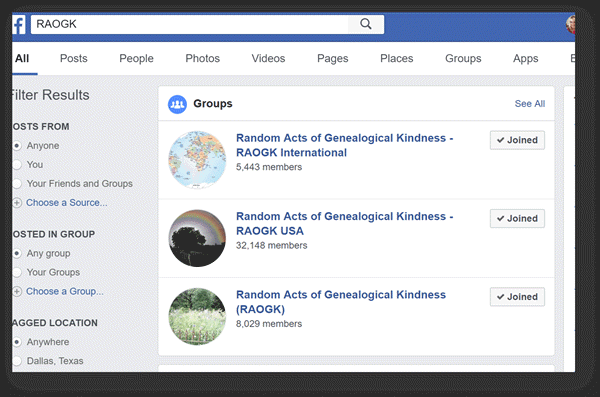
Get free genealogy records help on Facebook.
Learn More with these Resources
- Genealogy Gems Premium Membership: Genealogy & DNA video classes.
- The Genealogist’s Google Toolbox, by Lisa Louise Cooke.
- Genealogy Giants: Comparing the 4 Major Websites Quick Reference Guide.
Free Tools at MyHeritage for a Limited Time
Now through Sept. 10, 2020 you can get free access to Myheritage Photo Enhancer and MyHeritage In Color here.
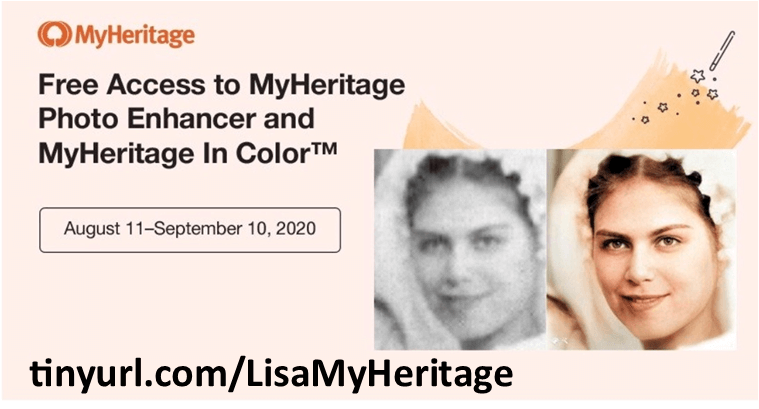
Resources for this Episode
- Live show chat log
- Premium Members: Download the show notes handout

